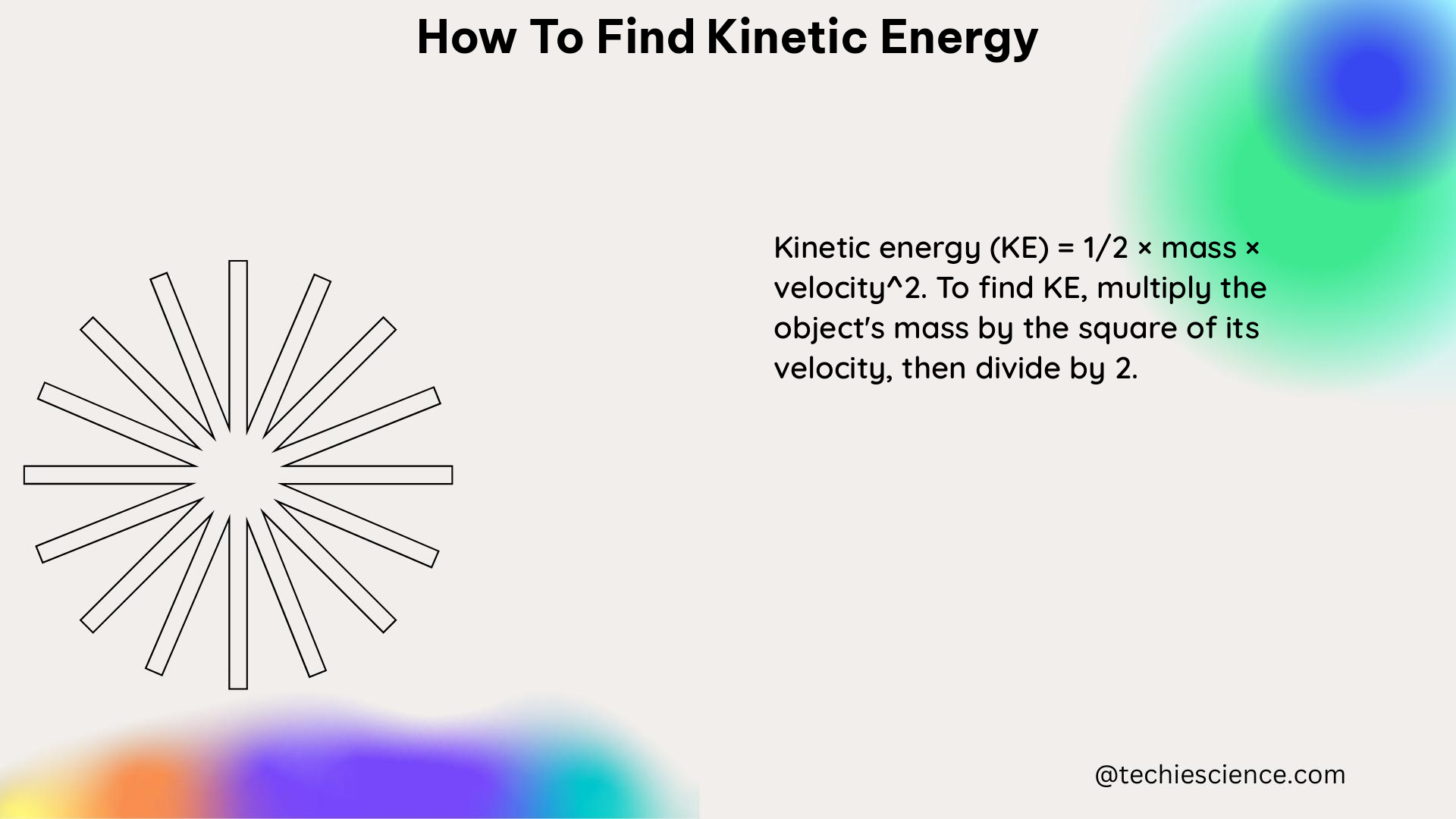Kinetic energy is a fundamental concept in physics that describes the energy an object possesses due to its motion. Determining the kinetic energy of an object is crucial for understanding and analyzing various physical phenomena, from the motion of everyday objects to the behavior of subatomic particles. In this comprehensive guide, we will delve into the intricacies of calculating kinetic energy, providing you with the necessary tools and knowledge to become proficient in this essential skill.
Understanding the Kinetic Energy Formula
The formula for calculating kinetic energy is:
KE = 1/2 * m * v^2
Where:
– KE is the kinetic energy of the object, measured in joules (J)
– m is the mass of the object, measured in kilograms (kg)
– v is the velocity of the object, measured in meters per second (m/s)
This formula is derived from the principles of classical mechanics and is a fundamental relationship in the study of energy and motion.
Applying the Kinetic Energy Formula

To find the kinetic energy of an object, you need to know its mass and velocity. Let’s consider a few examples to illustrate the process:
Example 1: Calculating the Kinetic Energy of a Car
Suppose you have a car with a mass of 2,000 kg moving at a velocity of 15 m/s. To find the kinetic energy of the car, you would plug the values into the formula:
KE = 1/2 * m * v^2
KE = 1/2 * 2,000 kg * (15 m/s)^2
KE = 450,000 J
Therefore, the kinetic energy of the car is 450,000 joules.
Example 2: Calculating the Velocity of an Object with a Given Kinetic Energy
Now, let’s say you have a person with a mass of 70 kg and a kinetic energy of 450,000 J (the same as the car in the previous example). To find the velocity of the person, you can rearrange the kinetic energy formula to solve for v:
KE = 1/2 * m * v^2
v = sqrt(2 * KE / m)
v = sqrt(2 * 450,000 J / 70 kg)
v = 113 m/s
So, the person would need to be moving at a velocity of 113 m/s to have the same kinetic energy as the car.
Factors Affecting Kinetic Energy
The kinetic energy of an object is directly proportional to its mass and the square of its velocity. This means that:
- Mass: An object with a larger mass will have a higher kinetic energy than an object with a smaller mass, given the same velocity.
- Velocity: An object with a higher velocity will have a significantly higher kinetic energy than an object with a lower velocity, given the same mass. This is because the kinetic energy is proportional to the square of the velocity.
For example, if you double the velocity of an object, its kinetic energy will increase by a factor of four (2^2 = 4).
Kinetic Energy and Potential Energy
In addition to kinetic energy, there is another form of energy called potential energy, which is the energy an object possesses due to its position or configuration. The total energy of an object is the sum of its kinetic energy and potential energy.
When an object is in motion, its total energy is the sum of its kinetic energy and potential energy. As the object moves, its kinetic energy and potential energy can change, but the total energy remains constant (assuming no external forces are acting on the object).
Practical Applications of Kinetic Energy
Kinetic energy is a fundamental concept in physics with numerous practical applications, including:
- Collision Analysis: Understanding the kinetic energy of objects involved in a collision is crucial for analyzing the forces, momentum, and energy transfer during the collision.
- Mechanical Work: Kinetic energy is directly related to the work done by a force, as the work done is equal to the change in kinetic energy.
- Energy Conversion: Kinetic energy can be converted into other forms of energy, such as electrical energy (e.g., in a generator) or thermal energy (e.g., in a braking system).
- Transportation and Machinery: Kinetic energy plays a crucial role in the design and operation of various transportation systems and machinery, where the efficient transfer and management of kinetic energy are essential.
- Sports and Athletics: Kinetic energy is a key factor in many sports and athletic activities, as it determines the force and power generated by moving objects, such as balls, projectiles, and athletes themselves.
Conclusion
Mastering the concept of kinetic energy is essential for any physics student or enthusiast. By understanding the kinetic energy formula, applying it to various examples, and recognizing the factors that affect kinetic energy, you can develop a deep understanding of this fundamental principle of physics. This knowledge will not only help you excel in your studies but also provide you with the tools to analyze and solve a wide range of real-world problems involving motion and energy.
References
- Kinetic Energy and Velocity
- Kinetic Energy Formula Derivation
- How Was the Formula for Kinetic Energy Found and Who Found It?
- Kinetic Energy and Potential Energy: Concepts and Formulas
- Practice Applying Velocity and Energy Formulas

The lambdageeks.com Core SME Team is a group of experienced subject matter experts from diverse scientific and technical fields including Physics, Chemistry, Technology,Electronics & Electrical Engineering, Automotive, Mechanical Engineering. Our team collaborates to create high-quality, well-researched articles on a wide range of science and technology topics for the lambdageeks.com website.
All Our Senior SME are having more than 7 Years of experience in the respective fields . They are either Working Industry Professionals or assocaited With different Universities. Refer Our Authors Page to get to know About our Core SMEs.